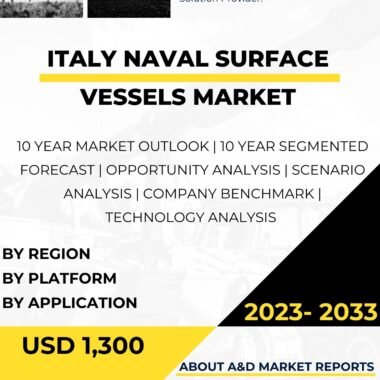Description
The South Korea naval surface vessels market is a critical segment of the country’s defense industry, providing a wide range of advanced warships and support vessels to strengthen its maritime security and project naval power. Naval surface vessels play a crucial role in safeguarding South Korea’s territorial waters, protecting maritime interests, and conducting a variety of military operations. The country’s focus on indigenous development, strategic partnerships, and technological innovation has positioned it as a major player in the global naval surface vessels market.
Naval surface vessels form the backbone of South Korea’s navy, supporting a variety of roles such as anti-submarine warfare (ASW), anti-surface warfare (ASuW), air defense, maritime patrol, amphibious operations, and humanitarian assistance and disaster relief (HADR) missions. These vessels are designed to operate in diverse environments, from coastal waters to open seas, and are equipped with advanced sensors, weapons systems, and communication capabilities to provide versatile and effective naval assets.
Indigenous development has been a cornerstone of South Korea’s defense strategy, and the naval surface vessels market is no exception. The country’s defense industry, represented by companies such as Hyundai Heavy Industries and Daewoo Shipbuilding & Marine Engineering (DSME), has made significant progress in designing and constructing advanced naval surface vessels tailored to meet the specific requirements of the South Korean Navy.
One of the key indigenous naval surface vessels in South Korea’s inventory is the “Incheon”-class frigate. These multi-purpose frigates are equipped with a range of modern sensors. The Incheon-class frigates enhance South Korea’s maritime security and contribute to regional stability by providing a credible deterrent against potential threats.
Beyond domestic requirements, South Korea actively seeks strategic partnerships with international defense and technology companies to enhance its naval surface vessels capabilities. Collaborations with global manufacturers enable technology transfer, joint research, and the integration of foreign systems into South Korea’s indigenous naval platforms. These partnerships contribute to the continuous improvement of South Korea’s naval surface vessels technology and reinforce its position in the global defense market.
Moreover, South Korea’s commitment to innovation and research and development (R&D) has driven advancements in naval surface vessels technology. The country invests in R&D programs to improve the performance, endurance, and versatility of its naval surface vessels. Technological improvements focus on enhancing propulsion systems, reducing acoustic signatures for improved stealth, and integrating unmanned systems and autonomous capabilities for increased operational flexibility.
As part of its broader defense industry, South Korea’s naval surface vessels market extends beyond domestic needs. The country actively exports naval surface vessels and related technologies to other nations, generating revenue and expanding its influence in the global defense market. Successful exports demonstrate the reliability and performance of South Korean-made naval surface vessels, contributing to the growth of its defense industry.
To ensure optimal utilization and proficiency in operating naval surface vessels, South Korea places significant emphasis on training and skill development for its naval personnel. Training programs focus on familiarizing crews with the operation, maintenance, and effective utilization of naval surface vessels in various operational scenarios.
Moreover, cybersecurity is a significant consideration in the naval surface vessels market, as modern warships often incorporate digital components and may be vulnerable to cyber threats. South Korea invests in robust cybersecurity measures to protect its naval assets and ensure the safety and security of naval surface vessels operations.
In conclusion, the South Korea naval surface vessels market is a critical aspect of the country’s defense capabilities. Indigenous development, strategic partnerships, and innovation have allowed South Korea to create advanced naval surface vessels that meet the specific needs of its naval forces. From frigates and destroyers to amphibious assault ships, these vessels provide South Korea with versatile and capable naval assets for a range of maritime missions. As the defense industry continues to evolve, South Korea’s dedication to advancing its naval surface vessels technology will remain essential in safeguarding its maritime interests and maintaining its position as a major player in the global naval surface vessels market.




